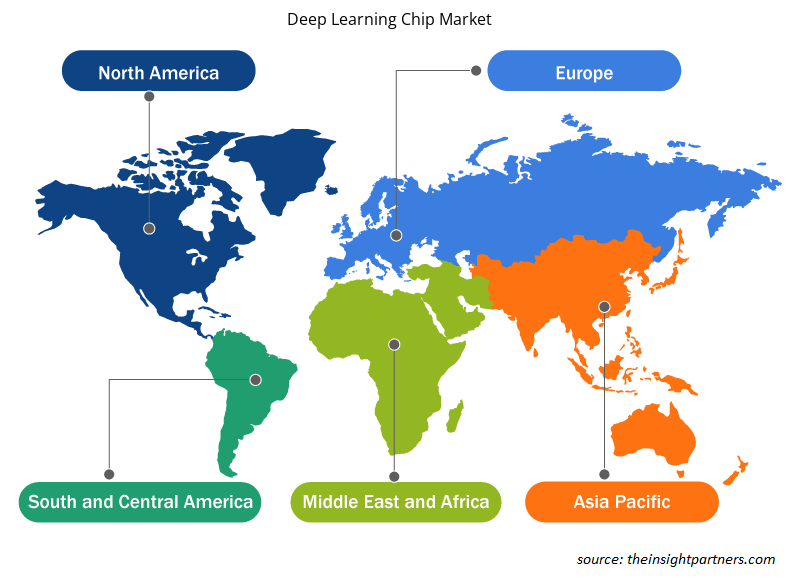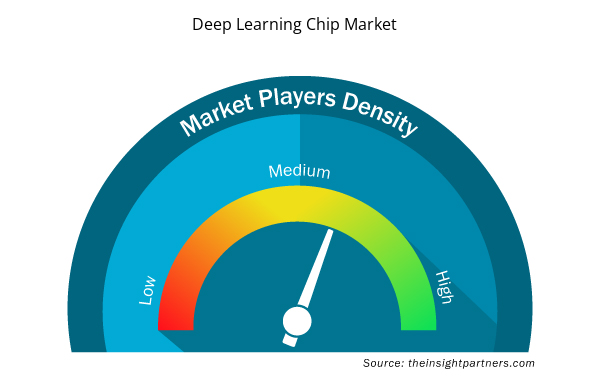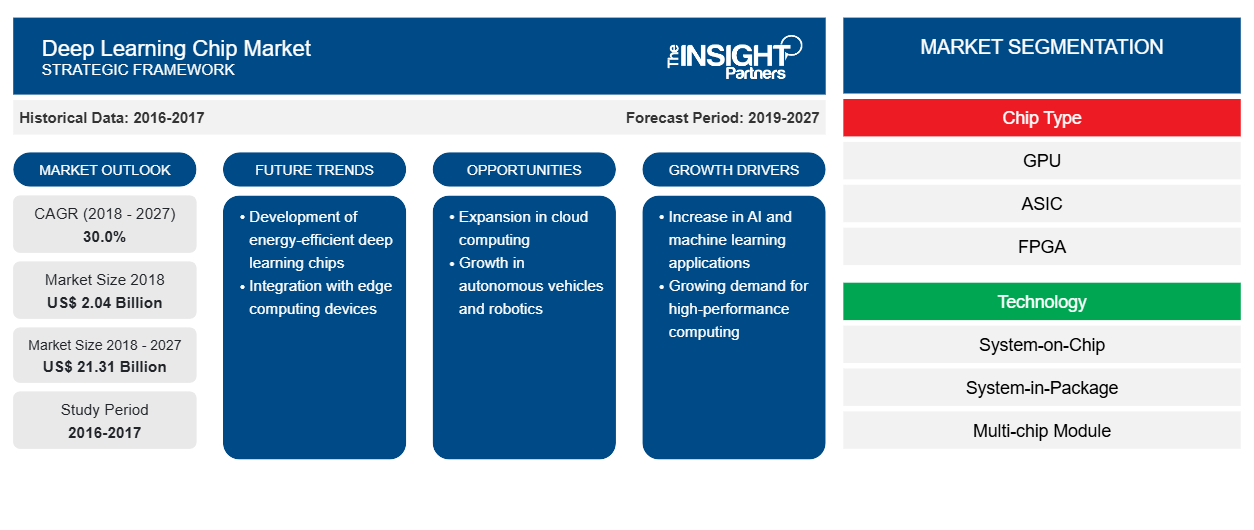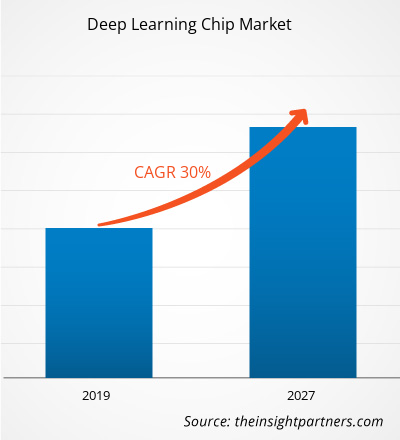Le marché mondial des puces d'apprentissage en profondeur représentait 2,04 milliards de dollars américains en 2018 et devrait croître à un TCAC de 30,0 % au cours de la période de prévision 2019-2027, pour atteindre 21,31 milliards de dollars américains d'ici 2027.
L'Amérique du Nord est le leader mondial du marché des puces d'apprentissage profond et devrait être le plus grand contributeur aux revenus tout au long de la période de prévision. Le développement des puces d'apprentissage profond est soutenu par des investissements à grande échelle de la part de géants technologiques pour développer des modèles à partir d'une énorme quantité de données générées. L'essor de l'informatique quantique et la mise en œuvre de puces d'apprentissage profond dans la robotique stimulent la croissance du marché des puces d'apprentissage profond dans les pays d'Amérique du Nord.
Informations sur le marché
L'importance de l'informatique quantique contribue à la croissance du marché des puces d'apprentissage profond
L'informatique quantique prend quelques secondes pour terminer un calcul qui prendrait autrement plus de temps. Les ordinateurs quantiques sont une transformation innovante de l'intelligence artificielle, de l'apprentissage automatique et du big data. Par conséquent, l'importance de l'informatique quantique devrait stimuler la croissance du marché des puces d'apprentissage profond. En outre, l'informatique quantique est bénéfique pour divers facteurs, notamment l'optimisation du portefeuille, la détection des fraudes et la gestion des risques, ainsi que les domaines où un retour d'information immédiat sur les données est nécessaire. Ainsi, il est plus facile pour un seul processeur d'effectuer des calculs complexes en quelques secondes. De plus, avec l' échelle et la taille d'Internet , l'apprentissage profond permet de conserver de grands ensembles de données à un coût très faible. Par conséquent, ces facteurs devraient stimuler la croissance du marché mondial des puces d'apprentissage profond
Personnalisez ce rapport en fonction de vos besoins
Vous bénéficierez d'une personnalisation gratuite de n'importe quel rapport, y compris de certaines parties de ce rapport, d'une analyse au niveau des pays, d'un pack de données Excel, ainsi que de superbes offres et réductions pour les start-ups et les universités.
- Obtenez les principales tendances clés du marché de ce rapport.Cet échantillon GRATUIT comprendra une analyse de données, allant des tendances du marché aux estimations et prévisions.
Des informations en temps réel sur le comportement des consommateurs et une efficacité opérationnelle accrue pour propulser la croissance globale du marché des puces d'apprentissage profond
La nature des affaires devient de plus en plus compétitive et pour être compétitives efficacement, les entreprises s'appuient aujourd'hui sur des informations utiles et des analyses commerciales. Traditionnellement, les outils d'analyse commerciale étaient utilisés pour projeter les ventes à partir de données sur des événements datant d'une semaine ou d'un mois. Avec l'avènement de la technologie de l'intelligence artificielle qui apprend en temps réel et fournit des recommandations basées sur des modèles, les entreprises ont une formidable opportunité d'appliquer l'apprentissage profond dans divers processus pour mieux comprendre l'environnement commercial et les clients.
Compte tenu de ces facteurs, l’intelligence artificielle permet aux entreprises d’améliorer l’efficacité opérationnelle, de réduire les coûts d’exploitation, d’améliorer la qualité du service et l’expérience client.
Informations sur les types de puces
Les unités de traitement graphique (GPU) détenaient la plus grande part de marché des puces d'apprentissage profond en 2018, tandis que les circuits intégrés spécifiques aux applications (ASIC) devraient être le segment qui connaîtra la croissance la plus rapide au cours de la période de prévision. En raison du fait que les ASIC sont très spécifiques et moins flexibles, ils constituent l'une des options matérielles les plus performantes disponibles pour les applications d'intelligence artificielle.
Informations sur la technologie
Les chipsets d'apprentissage profond comprennent les systèmes sur puce, les systèmes en boîtier, les modules multipuces et autres. Le segment des systèmes sur puce détenait la plus grande part de marché des puces d'apprentissage profond en 2018, car il contribue à réduire le gaspillage d'énergie, l'espace occupé par les grands systèmes et les coûts.
Informations sur les secteurs d'activité
Le marché mondial des puces d'apprentissage profond est classé en BFSI, vente au détail, informatique et télécommunications, automobile et transport, santé, médias et divertissement, et autres. BFSI détient la part de marché la plus importante sur le marché des puces d'apprentissage profond, tandis que les soins de santé devraient être le segment qui connaît la croissance la plus rapide du marché. Les facteurs tels que la réduction des coûts opérationnels, l'adaptation à l'évolution des conformités et des réglementations, la concentration sur l'activité principale et l'intégration de l'automatisation dans les processus commerciaux sont d'autres facteurs majeurs qui alimentent la croissance du segment BFSI sur le marché des puces d'apprentissage profond
Les acteurs du marché présents sur le marché des puces d'apprentissage profond se concentrent principalement sur les améliorations de produits en mettant en œuvre des technologies avancées. En signant des partenariats, des contrats, des coentreprises, des financements et en inaugurant de nouveaux bureaux à travers le monde, l'entreprise peut maintenir sa marque à l'échelle mondiale. Quelques-uns des développements récents sont énumérés ci-dessous :
2019 : NVIDIA s'est associé à Hackster.io pour lancer l'AI at the Edge Challenge, un concours où les développeurs utilisent le kit de développement NVIDIA Jetson Nano pour créer des projets créatifs et uniques et ont une chance de gagner 100 000 $ en prix.
2019 : Intel a annoncé son intention d'agrandir l'usine de l'Oregon pour produire une puce de 7 nm. La nouvelle usine d'Intel sera la troisième phase de D1X, une usine massive qu'Intel a commencé à construire en 2010. Chacune des deux premières phases représentait 1,1 million de pieds carrés, créant une installation combinée équivalente à 15 magasins-entrepôts Costco. La troisième phase augmentera apparemment l'espace de fabrication de D1X d'environ 50 %. De plus, Intel affirme que l'expansion de son usine lui permettra de répondre 60 % plus rapidement aux pénuries de puces.
2019 : Huawei a lancé HiSecEngine USG12000, le premier AIFW de niveau T du secteur. Le HiSecEngine USG12000 est équipé de puces Ascend AI, qui offrent des capacités de détection intelligentes ainsi qu'une défense intelligente des frontières pour les réseaux d'entreprise.
Aperçu régional du marché des puces d'apprentissage profond
Les tendances et facteurs régionaux influençant le marché des puces d’apprentissage profond tout au long de la période de prévision ont été expliqués en détail par les analystes d’Insight Partners. Cette section traite également des segments et de la géographie du marché des puces d’apprentissage profond en Amérique du Nord, en Europe, en Asie-Pacifique, au Moyen-Orient et en Afrique, ainsi qu’en Amérique du Sud et en Amérique centrale.

- Obtenez les données régionales spécifiques au marché des puces d'apprentissage profond
Portée du rapport sur le marché des puces d'apprentissage profond
| Attribut de rapport | Détails |
|---|---|
| Taille du marché en 2018 | 2,04 milliards de dollars américains |
| Taille du marché d'ici 2027 | 21,31 milliards de dollars américains |
| Taux de croissance annuel composé mondial (2018 - 2027) | 30,0% |
| Données historiques | 2016-2017 |
| Période de prévision | 2019-2027 |
| Segments couverts | Par type de puce
|
| Régions et pays couverts | Amérique du Nord
|
| Leaders du marché et profils d'entreprises clés |
|
Densité des acteurs du marché : comprendre son impact sur la dynamique des entreprises
Le marché des puces d'apprentissage profond connaît une croissance rapide, tirée par la demande croissante des utilisateurs finaux en raison de facteurs tels que l'évolution des préférences des consommateurs, les avancées technologiques et une plus grande sensibilisation aux avantages du produit. À mesure que la demande augmente, les entreprises élargissent leurs offres, innovent pour répondre aux besoins des consommateurs et capitalisent sur les tendances émergentes, ce qui alimente davantage la croissance du marché.
La densité des acteurs du marché fait référence à la répartition des entreprises ou des sociétés opérant sur un marché ou un secteur particulier. Elle indique le nombre de concurrents (acteurs du marché) présents sur un marché donné par rapport à sa taille ou à sa valeur marchande totale.
Les principales entreprises opérant sur le marché des puces d'apprentissage profond sont :
- Micro-appareils avancés, Inc.
- Alphabet Inc. (Google)
- Amazon.com, Inc.
- Baidu, Inc.
- Huawei Technologies Co., Ltd
Avis de non-responsabilité : les sociétés répertoriées ci-dessus ne sont pas classées dans un ordre particulier.

- Obtenez un aperçu des principaux acteurs du marché des puces d'apprentissage profond
SEGMENTATION DU MARCHÉ MONDIAL DES PUCES D'APPRENTISSAGE PROFOND
Par type de puce
- GPU
- Circuit intégré d'application spécifique
- FPGA
- Processeur
- Autres
Par technologie
- Système sur puce
- Système intégré
- Module multi-puces
- Autres
Par secteur d'activité
- Médias et publicité
- BFSI, IT & Télécom
- Vente au détail
- Soins de santé
- Automobile et transport
- Autres
Par géographie
Amérique du Nord
- NOUS
- Canada
- Mexique
Europe
- France
- Allemagne
- ROYAUME-UNI
- Russie
- Italie
- Reste de l'Europe
Asie-Pacifique (APAC)
- Australie
- Chine
- Inde
- Japon
- Corée du Sud
- Reste de l'APAC
Moyen-Orient et Afrique (MEA)
- Arabie Saoudite
- Afrique du Sud
- Émirats arabes unis
- Reste de la MEA
Amérique du Sud (SAM)
- Brésil
- Argentine
- Reste de SAM
Profils d'entreprise
- Micro-appareils avancés, Inc.
- Alphabet Inc. (Google)
- Amazon.com, Inc.
- Baidu, Inc.
- Huawei Technologies Co., Ltd
- Société Intel
- Société NVIDIA
- Qualcomm Incorporated
- Samsung Electronics Co., Ltd.
- Xilinx, Inc.
- Analyse historique (2 ans), année de base, prévision (7 ans) avec TCAC
- Analyse PEST et SWO
- Taille du marché Valeur / Volume - Mondial, Régional, Pays
- Industrie et paysage concurrentiel
- Ensemble de données Excel



Report Coverage
Revenue forecast, Company Analysis, Industry landscape, Growth factors, and Trends

Segment Covered
This text is related
to segments covered.

Regional Scope
North America, Europe, Asia Pacific, Middle East & Africa, South & Central America

Country Scope
This text is related
to country scope.
Questions fréquemment posées
The BFSI industry dominated the deep learning chip market in the year 2018. Banking, financial services, and insurance (BFSI) industries have great potential for deep learning chips due to the presence of huge financial and personal data of customers. In this sector, a high amount of sensitive data is generated and exchanged every day. There is growing volume and creation of endpoints and mobile devices in banks, credit card companies, and credit reporting institutions, thus, it becomes important for these industry verticals to harness this data to gain insights about various business aspects.
Presently, the major applications of deep learning chips are in the data center/cloud computing segment, and this trend is expected to continue during the forecast period. Also, majorly due to rising adoption of AI in developing regions, evolving architectures of deep learning chips and increasing applications across various industry verticals. Owing to this growing trend, the companies are anticipated to produce high-quality service by adopting cloud-based artificial intelligence services.
North America is one of the fastest-growing regions in terms of technological development. In the past 3 years, the region witnessed significant adoption of AI solutions across all the sectors. North America contributes the largest market share in terms of revenue, and it is estimated that it will continue its dominance in the market share during the forecast period. Deep learning chip development is backed by large-scale investment from technological giants to develop patterns from huge amount of generated data. The rise of quantum computing and implementation of deep learning chips in robotics drive the growth of the deep learning chip market in the North American countries.
Trends and growth analysis reports related to Electronics and Semiconductor : READ MORE..
The List of Companies - Deep Learning Chip Market
- Advanced Micro Devices, Inc.
- Alphabet Inc. (Google)
- Amazon.com, Inc.
- Baidu, Inc.
- Huawei Technologies Co., Ltd
- Intel Corporation
- NVIDIA Corporation
- Qualcomm Incorporated
- Samsung Electronics Co., Ltd.
- Xilinx, Inc.
The Insight Partners performs research in 4 major stages: Data Collection & Secondary Research, Primary Research, Data Analysis and Data Triangulation & Final Review.
- Data Collection and Secondary Research:
As a market research and consulting firm operating from a decade, we have published and advised several client across the globe. First step for any study will start with an assessment of currently available data and insights from existing reports. Further, historical and current market information is collected from Investor Presentations, Annual Reports, SEC Filings, etc., and other information related to company’s performance and market positioning are gathered from Paid Databases (Factiva, Hoovers, and Reuters) and various other publications available in public domain.
Several associations trade associates, technical forums, institutes, societies and organization are accessed to gain technical as well as market related insights through their publications such as research papers, blogs and press releases related to the studies are referred to get cues about the market. Further, white papers, journals, magazines, and other news articles published in last 3 years are scrutinized and analyzed to understand the current market trends.
- Primary Research:
The primarily interview analysis comprise of data obtained from industry participants interview and answers to survey questions gathered by in-house primary team.
For primary research, interviews are conducted with industry experts/CEOs/Marketing Managers/VPs/Subject Matter Experts from both demand and supply side to get a 360-degree view of the market. The primary team conducts several interviews based on the complexity of the markets to understand the various market trends and dynamics which makes research more credible and precise.
A typical research interview fulfils the following functions:
- Provides first-hand information on the market size, market trends, growth trends, competitive landscape, and outlook
- Validates and strengthens in-house secondary research findings
- Develops the analysis team’s expertise and market understanding
Primary research involves email interactions and telephone interviews for each market, category, segment, and sub-segment across geographies. The participants who typically take part in such a process include, but are not limited to:
- Industry participants: VPs, business development managers, market intelligence managers and national sales managers
- Outside experts: Valuation experts, research analysts and key opinion leaders specializing in the electronics and semiconductor industry.
Below is the breakup of our primary respondents by company, designation, and region:

Once we receive the confirmation from primary research sources or primary respondents, we finalize the base year market estimation and forecast the data as per the macroeconomic and microeconomic factors assessed during data collection.
- Data Analysis:
Once data is validated through both secondary as well as primary respondents, we finalize the market estimations by hypothesis formulation and factor analysis at regional and country level.
- Macro-Economic Factor Analysis:
We analyse macroeconomic indicators such the gross domestic product (GDP), increase in the demand for goods and services across industries, technological advancement, regional economic growth, governmental policies, the influence of COVID-19, PEST analysis, and other aspects. This analysis aids in setting benchmarks for various nations/regions and approximating market splits. Additionally, the general trend of the aforementioned components aid in determining the market's development possibilities.
- Country Level Data:
Various factors that are especially aligned to the country are taken into account to determine the market size for a certain area and country, including the presence of vendors, such as headquarters and offices, the country's GDP, demand patterns, and industry growth. To comprehend the market dynamics for the nation, a number of growth variables, inhibitors, application areas, and current market trends are researched. The aforementioned elements aid in determining the country's overall market's growth potential.
- Company Profile:
The “Table of Contents” is formulated by listing and analyzing more than 25 - 30 companies operating in the market ecosystem across geographies. However, we profile only 10 companies as a standard practice in our syndicate reports. These 10 companies comprise leading, emerging, and regional players. Nonetheless, our analysis is not restricted to the 10 listed companies, we also analyze other companies present in the market to develop a holistic view and understand the prevailing trends. The “Company Profiles” section in the report covers key facts, business description, products & services, financial information, SWOT analysis, and key developments. The financial information presented is extracted from the annual reports and official documents of the publicly listed companies. Upon collecting the information for the sections of respective companies, we verify them via various primary sources and then compile the data in respective company profiles. The company level information helps us in deriving the base number as well as in forecasting the market size.
- Developing Base Number:
Aggregation of sales statistics (2020-2022) and macro-economic factor, and other secondary and primary research insights are utilized to arrive at base number and related market shares for 2022. The data gaps are identified in this step and relevant market data is analyzed, collected from paid primary interviews or databases. On finalizing the base year market size, forecasts are developed on the basis of macro-economic, industry and market growth factors and company level analysis.
- Data Triangulation and Final Review:
The market findings and base year market size calculations are validated from supply as well as demand side. Demand side validations are based on macro-economic factor analysis and benchmarks for respective regions and countries. In case of supply side validations, revenues of major companies are estimated (in case not available) based on industry benchmark, approximate number of employees, product portfolio, and primary interviews revenues are gathered. Further revenue from target product/service segment is assessed to avoid overshooting of market statistics. In case of heavy deviations between supply and demand side values, all thes steps are repeated to achieve synchronization.
We follow an iterative model, wherein we share our research findings with Subject Matter Experts (SME’s) and Key Opinion Leaders (KOLs) until consensus view of the market is not formulated – this model negates any drastic deviation in the opinions of experts. Only validated and universally acceptable research findings are quoted in our reports.
We have important check points that we use to validate our research findings – which we call – data triangulation, where we validate the information, we generate from secondary sources with primary interviews and then we re-validate with our internal data bases and Subject matter experts. This comprehensive model enables us to deliver high quality, reliable data in shortest possible time.


 Obtenez un échantillon gratuit pour ce rapport
Obtenez un échantillon gratuit pour ce rapport